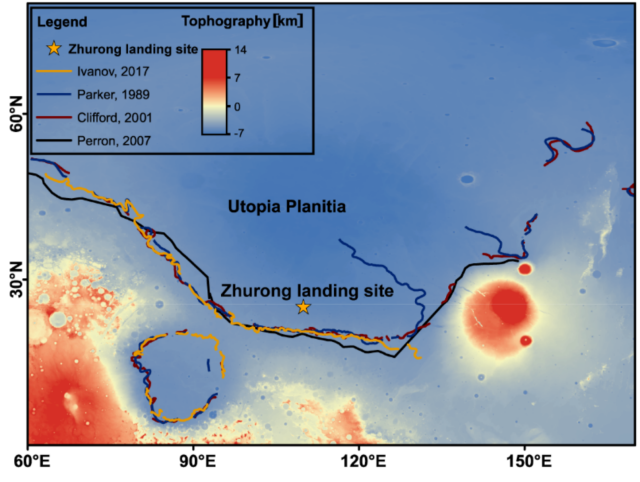Mars was once habitable! This groundbreaking conclusion was confirmed in a research paper titled "Ancient ocean coastal deposits imaged on Mars", published on February 25 in the journal Proceedings of the National Academy of Sciences of the United States of America, a top international comprehensive journal. The research team comprises scientists from institutions such as Guangzhou University, the Chinese Academy of Sciences, Tongji University, The Pennsylvania State University, and the University of California, Berkeley.

The research shows that in the landing area of the rover Zhurong, located in the southern part of Utopia Planitia in the northern hemisphere of Mars, there are multiple layers of oblique sedimentary structures from 10 to 35 meters underground. These geological features are highly similar to coastal deposits on Earth, providing the most direct underground evidence that an ancient ocean once existed in the middle and low latitudes of Mars.
"Ancient ocean deposits preserve the historical record of Martian climate change. Studying these deposits can help us understand how Mars transformed from a warm and humid planet to a cold and dry one. This, in turn, can guide humanity on how to transform the Martian environment to achieve long-term sustainable habitation on Mars," the research team stated.

Map of Utopia Planitia, landing site of Mars rover Zhurong and four possible ancient coastlines.
On May 15, 2021, China's first Mars rover, Zhurong, landed in the southern part of Utopia Planitia (109.925°E, 25.066°N). The Mars subsurface penetrating radar carried by Zhurong is a dual-frequency ground-penetrating radar system designed to detect underground structures and possible water ice.
Liu Hai, a professor with the School of Civil Engineering and Transportation at Guangzhou University and co-author of the study, said that this study analyzed the measured data of the low-frequency channel of the rover's penetrating radar and identified 76 dipping reflectors at depths between 10 and 35 meters below the surface along the path of Zhurong.
"These bedding structures are strikingly similar to the radar imaging results of beach deposits on Earth," Liu Hai said. Their consistency and physical properties rule out other formation causes such as wind-blown dunes, lava flows, or river alluvium.
In addition, the low permittivity of the coastal sediments discovered in the study is consistent with the dielectric constants of fine and medium sand particles on Earth, further confirming their nature as marine sediments.
The research team noted that the greatest significance of this discovery is expanding the evidence of Martian liquid water from the sparsely-populated polar regions to the more human-friendly middle and low latitudes. If there was once an ocean here, then with climate change, a large amount of water may be sealed in the form of underground ice, providing the possibility of utilizing water resources in future Martian bases.
This research was supported by the China National Space Administration and the team of China's first Mars exploration mission (Tianwen-1). It also received funding from the National Natural Science Foundation of China and the Guangdong Basic and Applied Basic Research Foundation.
Photo | Nanfang Plus
Editor | Zhou Jiajie (intern), Wang Lihan (intern), Zhong Haiqiong, Wei Shen, James, Shen He
















